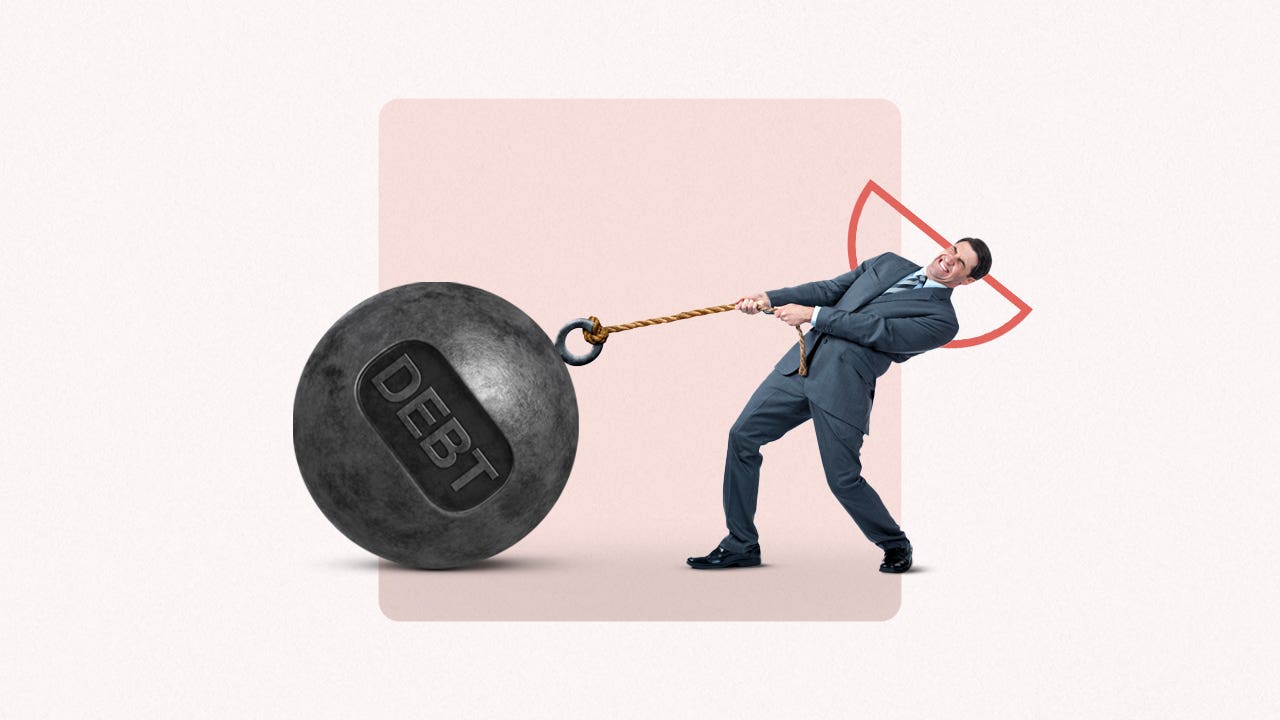How does debt consolidation work? Answers from someone who’s done it

The Bankrate promise
At Bankrate we strive to help you make smarter financial decisions. While we adhere to strict , this post may contain references to products from our partners. Here's an explanation for .
Key takeaways
- Debt consolidation take multiple streams of debt and combine them into one loan with a fixed, monthly payment.
- Only consider a debt consolidation loan if you're offered a lower interest rate than your previous loans.
- Debt consolidation loans can help you stay on top of your debt payments only if you can feasibly make the monthly payments, both now and in the future.
Debt consolidation is a popular way to manage and organize high-interest debt. This strategy consists of rolling multiple debts into a single account, often with a lower interest rate, to streamline repayment.
Understanding how debt consolidation works is crucial to selecting the best approach for your situation. You have several types of loans to choose from. Thankfully, it’s not too hard to find someone who’s taken out a debt consolidation loan and can share their experience. Bankrate loans editor Rhys Subitch tells us how they’ve benefited and what they’ve learned along the way.
How does debt consolidation work?
What is debt consolidation? Debt consolidation combines multiple loans into one fixed monthly payment.
Debt consolidation only makes sense if the interest rate of your new loan or line of credit is lower than the interest rates of the debts you’re consolidating. To optimize your total savings, focus on consolidating the debts with the highest interest rates first. Keep your loan term as short as possible.
If your monthly payments are a bit too high for your budget, you may be able to extend the loan term. While this may be more affordable in the moment, you’ll end up paying more in interest in the long run.
Most debt consolidation loans are fixed-rate, which means the interest rate never changes and you make the same payment every month. So if you have three credit cards with different interest rates and minimum payments, you could use a debt consolidation loan to pay off those cards. You’d have just one monthly payment to manage instead of three.
- Card 1 has a balance of $5,000 with an APR of 20 percent.
- Card 2 has a balance of $2,000 with an APR of 25 percent.
- Card 3 has a balance of $1,000 with an APR of 16 percent.
To calculate your potential savings through consolidation, use a credit card payoff calculator and a personal loan calculator.
What is the difference between debt consolidation and a personal loan?
Debt consolidation is a form of debt refinancing in which the borrower takes out a loan, credit card or line of credit and uses it to pay off other debts. This helps debt repayment as the borrower only has to worry about making a single payment each month.
Plus, there’s the potential of saving money down the line if they manage to secure a lower interest rate.
There are several ways to consolidate debt, including personal loans.
Personal loans are a type of installment loan, with a fixed rate and repayment term. Some lenders market personal loans specifically for debt consolidation. Debt consolidation loans generally have terms between one and seven years, and many will let you consolidate up to $50,000.
But debt consolidation isn’t the only way borrowers can use personal loans. Personal loans can be used for almost any purpose, from financing large purchases to home improvement projects.
What to look for in a debt consolidation loan
If you’ve ever shopped around for a loan before, chances are you know what to look for. However, because consolidation loans involve multiple debt streams, that monthly payment can add up fast.
When trying to find the best option for your situation, compare at least a few lenders and pay close attention to the features. The loan details are on the lender’s website or within its terms and conditions page.
The details to keep an eye out for include — but aren’t limited to — the loan type, the term and whether it’s secured or unsecured.
-
There are different types of debt consolidation options, including:
- Personal loan. These are often unsecured, with a fixed interest rate and repayment term of one to seven years.
- Balance transfer credit card. These cards often offer a 0 percent APR introductory period lasting between 12 and 18 months, followed by a variable interest rate. Good-to-excellent credit is often required to qualify. Only credit card debt can be transferred to these accounts. There’s typically a balance transfer fee of between 3 and 5 percent of the outstanding balance.
- Home equity loan. Home equity loans allow homeowners to tap into their equity and borrow against it. The home serves as collateral, so interest rates may be more competitive.
- Home equity line of credit (HELOC). Similar to home equity loans, HELOCs use your home as collateral and allow you to tap into your equity. The main difference, however, is that borrowers can draw funds as needed for a specified period. The interest rate is often variable.
- Eligibility requirements. Repayment terms.
- Interest rates.
- Minimum and maximum loan amounts.
- Kinds of debt you can consolidate.
-
A longer loan term could make your monthly payments more affordable. But it means that you’ll pay more in interest over the life of the loan.
You may find a shorter repayment term is better. Despite higher monthly payments, you’ll pay far less in interest and will be debt-free sooner. Before choosing a term, evaluate your budget and don’t stretch your finances too thin. -
Secured debt is easier to qualify for and typically comes with lower rates because the balance is backed by collateral. This means that the lender will require you to put up an asset to get approved. Depending on the loan requirements, this can be anything from a security deposit to a vehicle or even your home.
If you fail to make the payments or default on the loan, the lender can seize your collateral to make up for the delinquent payments. Unsecured loans are less risky for the borrower as they don’t require collateral. However, they are generally more difficult to get approved for.
How to manage a debt consolidation loan
The most important thing after taking out a debt consolidation loan is to avoid taking on more debt. Extra debt could defeat the purpose of taking the loan in the first place.
Likewise, it’s important to stay on top of payments. This helps you make progress and protects your credit score from taking a dip. One way to do this is by scheduling automatic payments.
“Using automatic payments is truly an anxiety buster for me. I don’t have to worry about missing a payment, and it’s one less task each month,” Subitch says.
They add that they now only have one payment instead of three and are able to pay a little extra each month when they have the funds.
What’s more, some lenders will offer a rate discount for opting for this form of payment, increasing your savings.
However, life is unpredictable. You may go through a hardship period that may make it difficult to keep up with your monthly bill.
If that happens, it’s crucial to be proactive and contact your lender. Though it may seem uncomfortable, lenders often have options in place that can temporarily reduce or pause payments in case of hardship. This, in turn, will keep your account current, while you get back on your feet.
How to tell if a debt consolidation loan is right for you
A debt consolidation isn’t the best option for everyone. In Subitch’s case, it made sense because it aligned with their long-term financial goals.
“My debt consolidation payment is a fairly large chunk of change,” Subitch says. “In total, my minimum payments would have actually been less than the debt consolidation loan, but it also would have taken significantly longer to pay off the entirety of it.”
A debt consolidation loan is worth considering if:
- You qualify for a lower interest rate. If you have good or excellent credit and plan to consolidate credit card debt, you’ll likely get a lower interest rate on a debt consolidation loan than you currently have on all your credit cards.
- You want a predictable monthly payment. The interest rate is fixed on most debt consolidation loans, which means you’ll get a predictable monthly payment that you can work into your budget. But a debt consolidation loan only makes sense if you can afford this amount.
- You’d prefer to pay a single creditor each month. Instead of scrambling to pay several creditors by the payment due dates, you’ll only pay one creditor each month. This could make it easier to can avoid late payment fees and adverse credit reporting.
However, if your credit score is fair or worse, it’s unlikely that you’ll qualify for a debt consolidation loan with a lower interest rate than you currently have.
It’s also best to avoid taking out a debt consolidation loan if your estimated monthly payment is more than what you can comfortably afford. In this case, you’re better off exploring other options, like reaching out to creditors to negotiate a payment arrangement.
The bottom line
Before you commit to consolidating, explore your loan options and details and assess your finances.
“Sit down and work out your budget,” Subitch advises. “Make sure that even if it’s more than your minimum monthly payments, it’s manageable.”
If you can qualify for a debt consolidation loan with a lower interest rate and a reasonable monthly payment, it could be a great way to streamline debt repayment and save money in interest. But if after exploring multiple offers, payments are still unmanageable, it may be best to look into other alternatives for relief.
Related Articles



